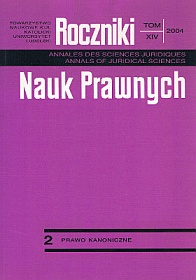The Right of Asylum in Ancient Rome
Abstract
The right of asylum in ancient Rome dates back to the royal epoch. The first place of asylum is supposed to have been granted in Rome by its legendary founder Romulus. In the period of the republic, the Roman state would reject this form of protection. Octavian, however, granted the right of asylum to a temple dedicated to the Caesar. In the Hellenistic provinces the right of asylum was very popular and it was abused. Tiberius commanded that it be checked whether particular temples had been granted this right. A form of asylum was popular in Rome, i.e. a resort to statues and images of the Caesar, a custom that was criticised by Roman jurists. The right of asylum was granted to temples by virtue of the law of consecration. Together with the fall of pagan religion, pagan temples lost their right of asylum. Christianity had added its own ideas to the right of asylum. In comparison with the past, an essential difference was that it could gain protection for the right of asylum in all Christian temples. The crucial difference was that it could gain protection for the right of asylum in all Christian temples. The laws concerning the right of asylum were issued by caesars in the years of 386-545.
The caesarean constitutions legally sanctioned the actual state of affairs, and introduced legal regulations as regards the fact of the protection of the right of asylum. The caesarean constitutions may be treated as executive regulations to the principle that is based on the church foundation of the law. Inasmuch as the adage Ecclesia vivit lege Romana is universally acknowledged (its first written form can be found in the lex Ribuaria, published in the first half of the seventh century), in the case of the right of asylum in Christian temples one can assume a reverse order – lex Romana vivit iure ecclesiastico. It has its ontological and chronological justification, if one takes into account that the right of asylum was formulated in the church legislature at the Council of Sardica in 342.
Copyright (c) 2004 Roczniki Nauk Prawnych

This work is licensed under a Creative Commons Attribution-NonCommercial-NoDerivatives 4.0 International License.


